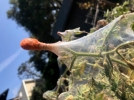
Invertebrates
See our handy guide to critters found in local homes and our Central Coast Butterfly FAQ. Browse the insects and other terrestrial arthropods we’ve identified. Check out local marine invertebrates, particularly bivalve mollusks and intertidal organisms.
- Anthropology
- Rocks & Fossils
- Invertebrates
- Vertebrates
- Botany
- Astronomy
- Fungi
- General
- Recently Asked
Tiny orange spiders?
Do you know what these are? There are several clusters on one of our tomato plants.

Curator Response
Hi Jane,
The critters in your photo appear to be spider mites. Mites belong to the class Arachnida, along with spiders, scorpions, and harvestmen, almost universally characterized by having eight legs in the adult stage. These mites in particular are gregarious plant-feeders in the family Tetranychidae, and can be terrible pests of certain garden plants. My best guess (and it is only a guess, without being able to examine these microscopically) is that these are the appropriately named Tomato Red Spider Mite, Tetranychus evansi. Most members of the Tetranychidae are able to spin silken webs, an ability dramatically illustrated in your photo. Similarly to certain caterpillars, the mites create these webs in order to be protected from predators and from the elements while they feed. Each individual adult mite is only about half a millimeter long; they sport a pair of stylets (mandibles modified in the form of tiny, sharp needles) on the front of the head, used to pierce individual plant cells and suck them dry.
This species is thought to have originated in South America (the native range of the tomato), but has since spread almost throughout the world in warm areas. It also feeds on other members of the tomato genus (Solanum), plus occasionally feeds on other plants in the family Solanaceae, including potatoes, eggplants, and tobacco.
Stay curious,
Schlinger Chair and Curator of Entomology Matthew L. Gimmel, Ph.D.

